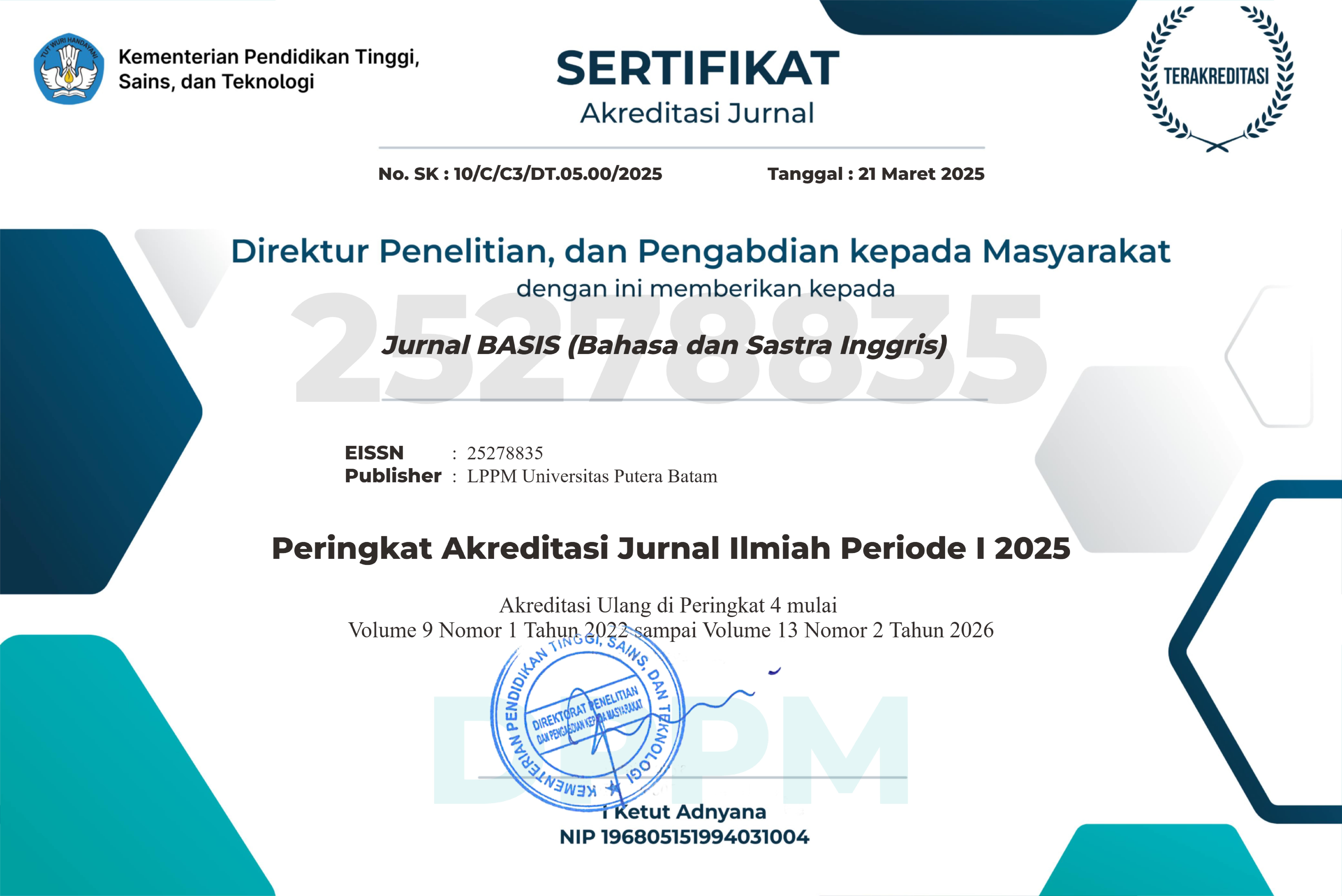A COMPARATIVE STUDY: GENETIC STRUCTURALISM ON JANE EYRE AND THE GREAT GATSBY
DOI:
https://doi.org/10.33884/basisupb.v6i1.1054Keywords:
Jane Eyre,, the Great Gatsby,, General Structuralism, Characteristics, Periods.Abstract
This study is comparative study which compares Jane Eyre and the Great Gatsby by using Genetic Structuralism. These two novels were written and published from different period. Different period commonly produces different culture, tradition, habit, work, creation, effort, and even different masterpiece. Most people claim that as the time goes by, the old ones will be replaced by the youths, and everything which had been done in the past, might not be done anymore in the present or even in the future. In fact, it is necessary to dig more about the history itself to know how the people at particular period live and how they contribute a society. This study is compiled as a research to study about the characteristic of the society when the novels has been published and the period when the author of the literary works lived while mainly discussed about how different periods create different kind of stories. It also mainly focuses to take a glance on how society impacts the authors’ thought and perception to create such literary works.
References
Bronte, Charlotte. (2011). New ed. Jane Eyre. London: Vintage.
Fitzgerald, F. Scott. (2000). 3rd ed. The Great Gatsby. New York: Penguin Classics.
Secondary Sources
Andersson, Angela. (2011). Identity and independence in Jane Eyre. Sweden: Mid Sweden University Press.
Bassnett, Susan. (1993). Comparative literature: a critical introduction. Oxford: Blackwell Publishers Ltd.
Bloom, Harold. (1985). Modern Critical Views: F. Scott Fitzgerald. New York: Chelsea House Publishers.
Bruccoli, Clark. (1973) The Great Gatsby: A fascimile of the manuscript. Washington, D. C: NCR.
Chesire. (2011) Literary anlysis of Jane Eyre. Retrieved from https://sites.google.com/a/cheshire.k12.ct.us/victorian-era/influential-authors/the-bronte -sisters/biography/jane-eyre-analysis/literary-anlysis-of-jane-eyre.
Cody, David. (2004). Charlotte Brontë: A brief biography.
Retrieved from http://www.victorianweb.org/ authors/bronte/cbronte/brontbio.html.
Cody, David. (2012) Social class. Retrieved from http://www.victorianweb.org/history/Class.html.
Cowley, Malcolm. (2006). The stories of F. Scott Fitzgerald. Retrieved from http://www.history.com/topics/f-scott-fitzgerald.
Darcy. (2014). What are common characteristics of Victorian Literature? Published in 2007. Retrieved from http://www.goodreads.com/topic/show/6556-what-are-common-characteristics-of-victorian-literature. Web.
Eagleton, Terry. (1976). Marxism and Literary Criticism. London: Routledge.
Falth, Sebastian. (2013). Social class and status in Fitzgerald’s the Great Gatsby. Sweden: Halmstad University Press.
Gaskell, Elizabeth. (2004) The life of Charlotte Brontë. Retrieved from http://lang.nagoya-u.ac.jp/~matsuoka/EG- Charlotte.html.
Goldman, Lucien. (1971). Reflections on History and Class Consciousness. Eng trans by P. France. in Mészáros, I. [Aspects of History and Class Consciousness, pp 65–84]. London, Routledge & Kegan Paul.
Goldman, Lucien. (1964). The hidden God: a study of tragic vision in the Pensees of Pascal and the tragedies of Racine. Eng Trans by Philip Thody. London: Routledge.
Kurasige, Scott. (2012). Each Generation Must Discoverr Its Own History: Some Thoughts on The Richard Aoki Debate (Part 1). Retrieved from http://www.8asians.com/2012/08/27/each-generation-must-discover-its-own-history-some-thoughts-on-the-richard-aoki-debate-part-1/.
Lorcher, Trent. (2014). Modernism in Literature: Quick Overview. Retrieved from http://www.brighthubeducation.com/high-school-english-lessons/29453-modernism-in-literature/.
Lundén, Rolf, Srigley, Michael. (2009). Ideas and Identities; British and American Culture. Lund: Studentlitteratur.
Martin, Robert. (1966). Charlotte Brontë's novels: the accents of persuasion. New York: Norton.
Matthew, J. (1999). Nw essays on the Great Gatsby. Cambridge: Cambridge Univ Press.
Mayer, Sonja. (2014) Victorians and their attitudes towards health. Retrieved from http://www.victorianweb.org/authors/bronte/cbronte/jane9.html
Meyer, Jim. (1997). What is Literature? A Definition Based on Prototypes. Work Papers of the Summer Institute of Linguistics, University of North Dakota Session. North Dakota: University of North Dakota Press, 41 (1), 42.
Milton. (2000). Periods of English Literature. Retrieved from http://home.comcast.net/~stephen.gottlieb/romantic/periods.html.
Mizener, Arthur. (1957). Afternoon of an Author. Princeton: Princeton University Library, 1957; London: Bodley Head, 1958). Retrieved from http://www.biography.com/people/f-scott-fitzgerald-9296261#early-life&awesm=~oHgr6KMJ5a1wQQ. Web.
Nestor, Pauline. (1987). Charlotte Brontë. Totowa, New Jersey: Barnes & Noble Books.
Nur’aini, Witri. (2009). Genetic Structuralism Analysis on Lucky Jim by Kingsley Amis. Jakarta: State Islamic University Syarif Hidayatullah Press.
Peters, Maureen. (1974). An Enigma of Brontës. New York: St. Martin’s Press.
Schneider, Helmuth. (2007). Technology, in Scheidel, Walter; Morris, Ian; Saller, Richard. [The Cambridge Economic History of the Greco-Roman World]. New York: Cambridge University Press.
Stern, Milton R. (1971). The Golden Moment: The Novels of F. Scott Fitzgerald. Urbana: University of Illinois Press.
Sumo, Nova. (2014). Parallels between charlotte bront�'s life and Jane Eyre. Retrieved from https://sumonova.com/parallels-between-charlotte-bronti%C2%BDs-life-and-jane-eyre/.
Tyson, Louis. (2006). Critical Theory Today 2nd Ed. New York: Routledge.
Downloads
Published
Issue
Section
License













 JURNAL BASIS (BAHASA DAN SASTRA INGGRIS)
JURNAL BASIS (BAHASA DAN SASTRA INGGRIS)
